Lecture 6 - Social and Personality Development in Infancy
1/54
There's no tags or description
Looks like no tags are added yet.
Name | Mastery | Learn | Test | Matching | Spaced |
|---|
No study sessions yet.
55 Terms
Proximity
It is practical:
Multi-tasking care and other responsibilities
Protect baby from harm
It has bonding
Skin-to-skin
Emotional bonding
Comfort and affection
Aids social + language development in exchanging expressions + speaking
Psychoanalytic theory
(Theories of development)
Psychosexual stages of development
Oral
Anal
Phallic
Latent
Genital
About satisfying basic drives. Nursing and weaning = important social components. Weaning must be managed to need to suck is neither frustrated OR over satisfied because a fixation will develop
Ex: Manifestation of oral fixation: oral behaviors like nail biting and swearing
Symbiotic relationship between mother and infant
Balanced weaning allows development of both attachment and separation from anxiety
Psychosocial theory
(Theories of development)
Development happens through interaction between internal drives and cultural demands across 8 stages
Stresses the importance of infants’ other needs
First two years = trust vs. mistrust (infant either learns to trust world around them or becomes cynical about enviornments ability to meet their needs)
Research supports psychosocial more than psychoanalytic
Ex: Famous monkey study
Attachment theory - ethological POV
(Theories of development)
All animals have innate predispositions that greatly influence development. This theory says that evolution has led infants to develop genes that predispose them to form emotional bonds with caregivers.
Infants’ capacity for forming social relationships is greatly resistant to environmental forces, including the quality of parenting
Expectations is the first two years are the SENSITIVE period for formation of caregiver relationships
Failure to form such relationships put child at risk for future social and personality problems
Attachment theory - internal model
(Theories of development)
Developed by John Bowlby— infants create different internal models of their relationships w/ parents and other central adults
Child’s confidence that attachment figure will be available or reliable
Expectation of rebuff or affection, assurance that the caregiver is a safe basis for exploration
Formation begins in first year and gets established thru ages 4/5
3 models by age 5:
Internal model of primary caregiver
Self model
Model of relationships
Models affect memory and attention—> notice and remember experiences that FIT the model, forget those that don’t fit
Affect behaviour by recreated patterns in new relationships
Attachment
Emotional bond from which a person’s sense of security in the relationship is derived
This is where an infant develops security — from their caregiver
Not dependent on bio, but on quality + quantity of interactions between infant and caregiver
Parent’s attachment to infant
(Attachment)
Skin-to-skin immediately after birth is NOT enough— need synchrony. Father/other caregivers’ bond MORE dependent on synchrony than skin-to-skin after birth.
Specialization of parental behaviours begin after first weeks of infant’s life cuz of hormonal diff.
6 mo. in: infants have distinct patterns of responding to these differences
Implications for generalizing conclusions about attachment, based on relationships w/ mothers compared to other caregivers
Synchrony
(Attachment → parent attachment to infant)
Mutual, interlocking pattern of attachment behaviours shared by parent and child
Father’s influence
(Attachment)
Infants whose dads don’t engage in play have higher risks of extra aggression and other behavioural problems in childhood.
Timing and type of father involvement impacts quality of father-child attachment
Implications for father’s involvement in traditional caregivers
Fathers involvement = beneficial ACROSS cultures
Infant’s attachment to parents
(Attacgment)
Based on the ability to tell between their parents and other people. Can recognize mom’s voice BEFORE birth, then by sight and smell after a few days. Cognitive foundation for attachment exists within days.
Bowlby said there was 4 phases in development of infant’s attachment
Phases appear in fixed order over 24-36 mo.
Four phases of attachment (NFSI)
(Attachment)
Non-focused orienting and signalling → “IDK phase”
Focus on one or more figures → “shy phase”
Secure base behaviour → “clingy phase”
Internal model → “finished phase”
“New friends stay inspired → IDK, shy, clingy, fin.”
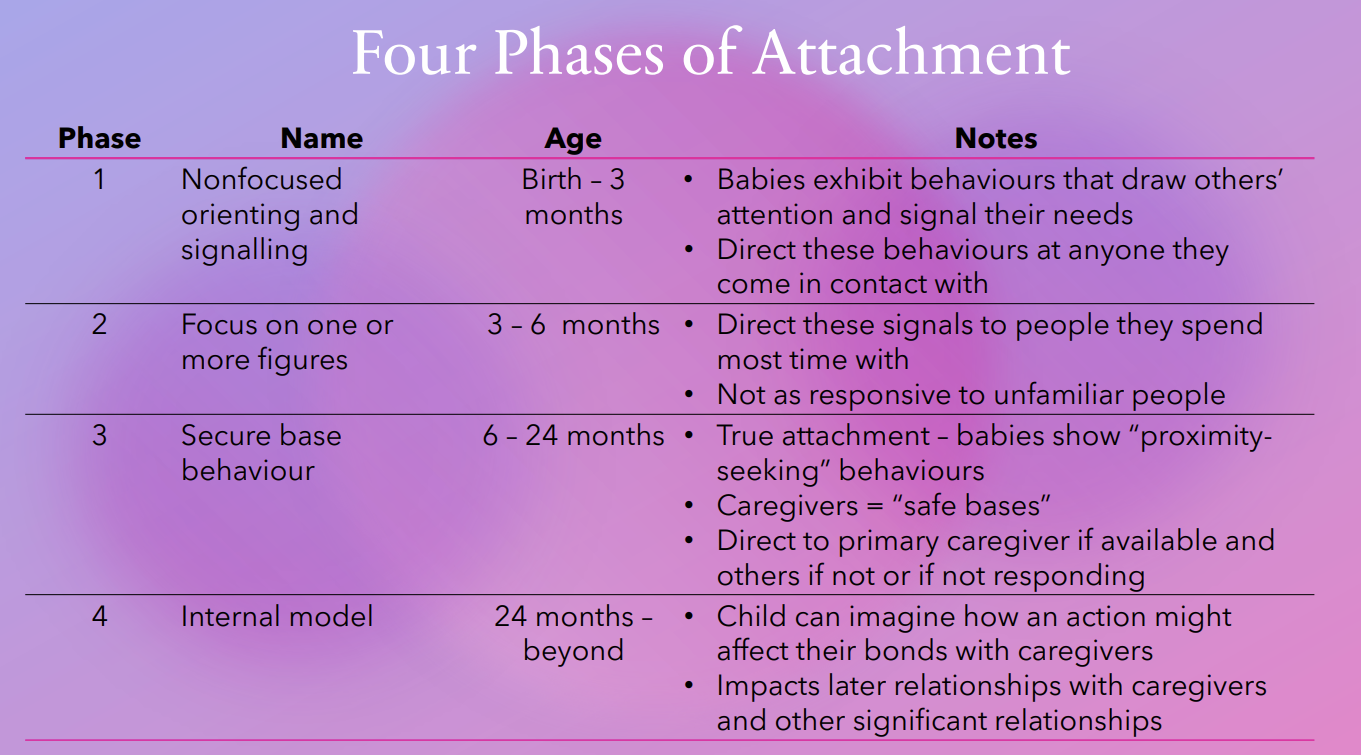
1) Nonfocused orienting and signalling
(Attachment → four phases of attachment/NFSI)
“IDK phase".” Babies exhibit behaviours that draw others’ attention and signal their needs. They direct these behaviours at anyone they come in contact with
Birth-3 months
“New friends stay inspired → IDK, shy, clingy, fin.”
2) Focus on one or more figures
(Attachment → four phases of attachment/NFSI)
“Shy phase”. Direct signals to people they spend most time with. Not as responsive to unfamiliar people.
3-6 months
“New friends stay inspired → IDK, shy, clingy, fin.”
3) Secure base behaviour
(Attachment → four phases of attachment/NFSI)
“Clingy phase”. True attachment— babies show proximity-seeking behaviours. Caregivers are the “Safe bases”. Directed to caregiver if available, and others if not.
6-24months
“New friends stay inspired → IDK, shy, clingy, fin.”
4) Internal model
(Attachment → four phases of attachment/NFSI)
“Finished phase”. Child can imagine how an action may affect bonds with caregivers. Impacts later relationships with caregivers, and other important relationships.
24 months - beyond
“New friends stay inspired → IDK, shy, clingy, fin.”
Attachment behaviours
(Attachment)
Stranger anxiety
Separation anxiety
These emerge around 6 mo., get more frequent around 12-16mo.
Stranger anxiety first, separation anxiety lasts longer
Social referencing plays a part.
Stranger anxiety
(Attachment → behaviours)
Expressed discomfort in the presence of strangers. Comes first.
Emerge 6mo., gets more frequent until 12-16mo.
Separation anxiety
(Attachment → behaviours)
Expressed discomfort about being separated from primary caregivers. Lasts longer.
Emerge 6mo., gets more frequent until 12-16mo.
________ DISORDER is where ________ (a natural response) becomes maladaptive
Social referencing
(Attachment → behaviours)
Use of caregiver’s facial expressions and tone of voice to guide their own emotions or behaviours in new situations
Helps babies regulate their emotions
Nature of emotional interactions between child and caregiver(s) = predictor of child’s future ability to control emotions
Aimsworth Attachment Styles (SAAD)
(Attachment)
Ainsworth system is the standard— key study: the strange situation.
Children’s reactions, particularly to the reunion, could be categorized into these:
Secure attachment
Avoidant attachment
Ambivalent attachment
Disorganized/disoriented attachment
Whether child cries during separation or not is NOT a good indicator
Have been observed cross-culturally
Relatively stable across the lifespan— major life events can alter it.
Internal model STILL relevant, person-specific in early years. Generalizes across relationships by age 4-5
Myth: Autism is caused by disturbance to the attachment process. WRONG! Most kids with ASD are securely attached to caregivers, and ASD as neurological origins
1) Secure attachment (SAAD)
(Attachment → Aimsworth Attachment styles/SAAD)
Ready separation, seeks proximity when stressed, parent is “safe-base” for exploration. Most common
Contingent responsiveness: consistent and appropriate
More likely if parents are married (possible confounding variables)
Marital conflict → infant withdrawal → less synchrony → lower chance of ________
Long-term consequences include…
More sociable, positive in behaviour to others, less clingy and dependent on teachers, less aggressive/disruptive, more empathetic, more emotionally mature in interactions outside the home
As teens: have more social skills closer friendships, more likely to be leaders, higher self-esteem better grades
2) Avoidant attachment (SAAD)
(Attachment → Aimsworth Attachment styles/SAAD)
Avoids contact with parent, no preference for parent/adult
Contingent responsiveness: consistent rejection or over-intrusiveness
Have less supportive friends, tend to become sexually active earlier, tend to practice riskier sex
Adults’ internal model affects parenting behaviours and more likely to form insecure attachments with their children
3) Ambivalent attachment (SAAD)
(Attachment → Aimsworth Attachment styles/SAAD)
Confused or apprehensive, shows contradictory behaviour.
Contingent responsiveness: NOT consistently availble
Have less supportive friends, tend to become sexually active earlier, tend to practice riskier sex
Adults’ internal model affects parenting behaviours and more likely to form insecure attachments with their children
4) Disorganized/disoriented attachment (SAAD)
(Attachment → Aimsworth Attachment styles/SAAD)
Catch-all category.
Contingent responsiveness: Abuse of child or parental history of abuse
Have less supportive friends, tend to become sexually active earlier, tend to practice riskier sex
Adults internal model affects parenting behaviours and more likely to form insecure attachments with their children
Caregiver influences + attachment
(Attachment → Aimsworth Attachment styles/SAAD)
Emotional responsiveness plays a part
Emotionally available caregiver
Contingent responvieness
SAAD
Marital status → marriage increases chances of secure attachment
Mental health:
Depression can reduce parent’s capacity to interpret and respond to infant’s signals
Parents w/ anxiety or depression are more likely to describe their babies as difficult
(Mental health challenges do not INHERENTLY have a neg. impact on baby attachment)
Emotionally available caregiver
(Attachment → Aimsworth Attachment styles/SAAD → caregiver influences)
Willing and able to form an emotional attachment with baby
Contingent responsiveness
(Attachment → Aimsworth Attachment styles/SAAD → caregiver influences)
Sensitivity and appropriate response to child’s cues
SAAD affects it all differently
Secure: consistent and appropriate
Avoidant: consistent and rejection or over-intrustiveness
Ambivalent: inconsistently available
Disorganzied: abuse of kid or history of parental abuse
4 general attachment styles (SAAF)
(Attachment)
On a range from high-low avoidance, and high-low anxiety.
4 kinds:
Secure attachment
Anxious (ambivalent) attachment
Avoidant attachment
Fearful (disorganized attachment)
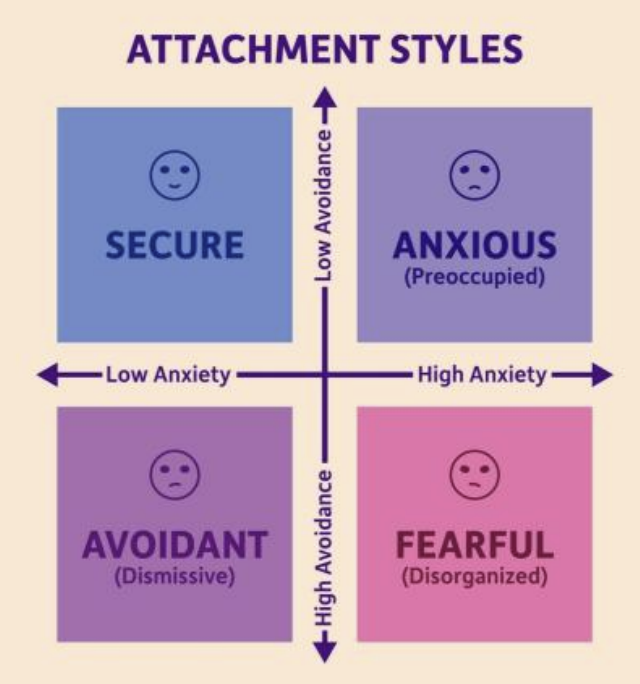
1) Secure attachment (SAAF)
(Attachment → 4 general attachment styles/SAAF)
Good emotional regulation, can trust others, comfortable being alone, good communication.
LOW avoidance, LOW anxiety
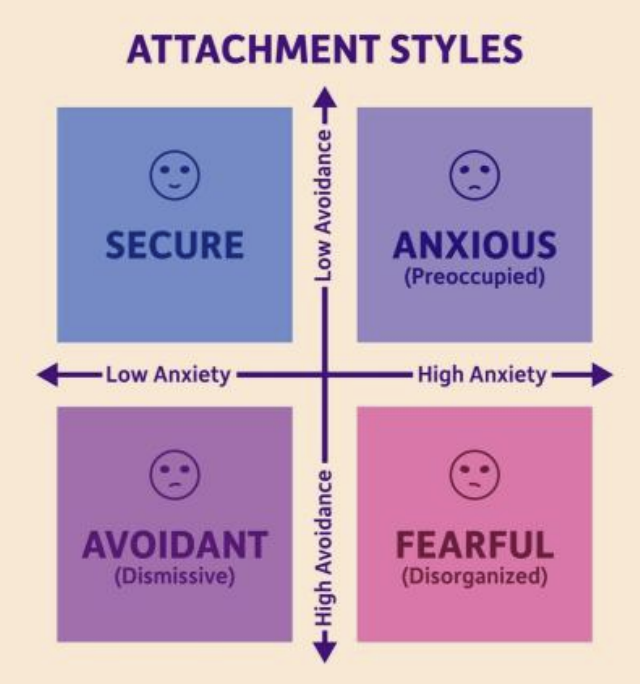
2) Anxious attachment (SAAF)
(Attachment → 4 general attachment styles/SAAF)
AKA ambivalent, sensitive to criticism, tendency to cling to others, difficulty being alone, low self-esteem, fear of rejection
LOW avoidance, HIGH anxiety
3) Avoidant attachment (SAAF)
(Attachment → 4 general attachment styles/SAAF)
Avoids intimacy, strong sense of independence, difficulty expressing emotions or trusting others, trouble committing
LOW anxiety, HIGH avoidance
4) Fearful attachment (SAAF)
(Attachment → 4 general attachment styles/SAAF)
AKA disorganized, difficulty regulating emotions, anxious, difficulty trusting others, fear of rejection
HIGH anxiety, HIGH avoidance
Personality
Pattern of responding to people and objects in the environment
relatively stable across lifespan
Individual diff. develop thru childhood and teenhood based on temperament
Temperament
Innate behavioural and emotional predispositions that form the foundations of personality
Thomas and Chess: EDS children
(Temperament → theoretical POV)
A categorial POV.
3 temperament classes
Easy children: 40%
Difficult children: 10%
Slow-to-warm-up children: 15%
Remaining children: 35%
1) Easy children (EDS)
(Temperament → theoretical POV → EDS)
40%: Approach new events positively, stable sleeping + eating cycles, generally happy, adjust well to change
Secure attachment
2) Difficult children (EDS)
(Temperament → theoretical POV → EDS)
10%: Irregular sleeping + eating cycles, irritable and emotionally negative, resistant to change
Ambivalent/anxious attachment
3) Slow-to-warm-up children
(Temperament → theoretical POV → EDS)
15%: Few intense reactions (pos OR neg), nonresponsive to unfamilar people
Avoidant attachment
4) Remaining children
(Temperament → theoretical POV → EDS)
35%: Exhibit combinations of the other categories.
Disorganzied/fearful atttachment
Trait theory of temperament (AAIIE)
(Temperament → theoretical POV)
How much or how little of various characteristics a child has → combo MATTERS
Five dimensions:
Activity level
Approach/positive emotionality/sociability
Inhibition and anxiety
Irritability/negative emotionality/anger
Effortful control/task persistence
"All Amazing Individuals Inspire Excellence"

1) Activity level (AAIIE)
(Temperament → theoretical POV → AAIIE)
Low end: remaining passive or immobile
High end: Moving often and vigorously
"All Amazing Individuals Inspire Excellence"
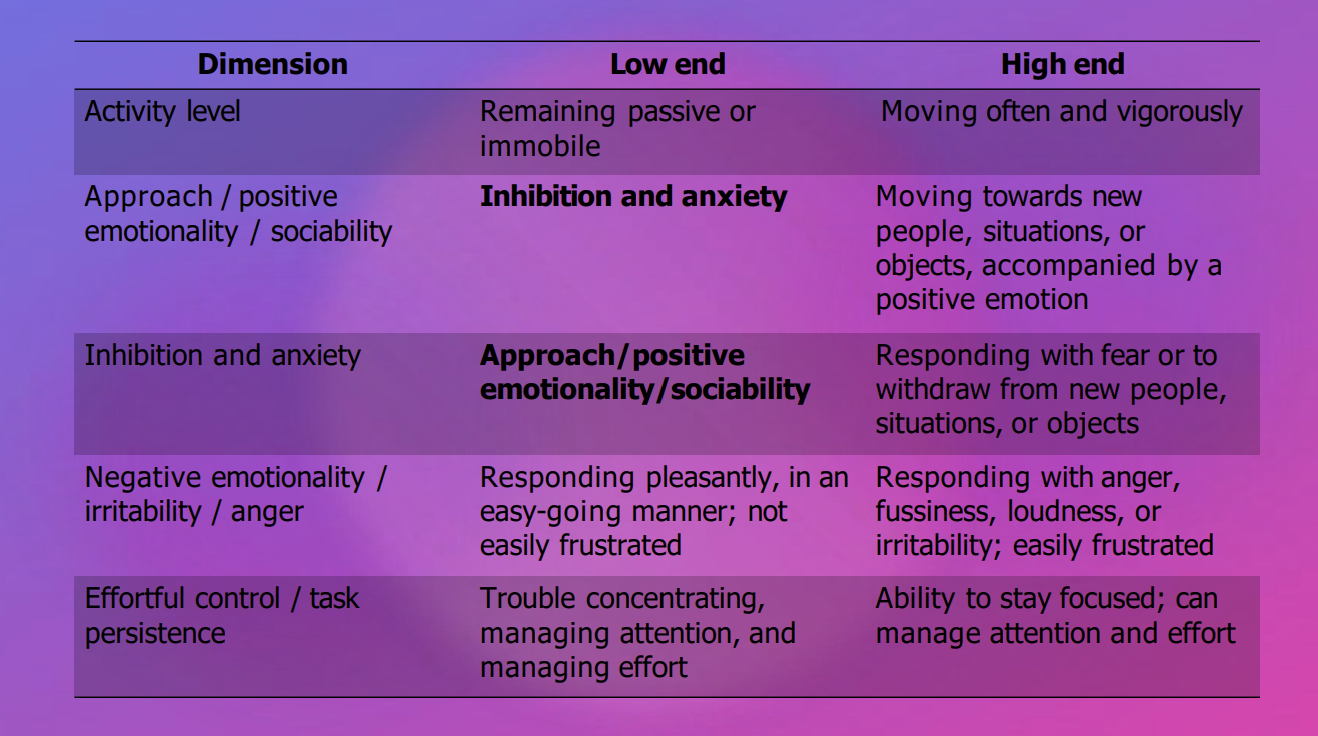
2) Approach (AAIIE)
(Temperament → theoretical POV → AAIIE)
Low end: Inhibition and anxiety
High end: Moving towards new people, situations, or objects, accompanied by a POSITIVE emotion
"All Amazing Individuals Inspire Excellence"

3) Inhibition and anxiety (AAIIE)
(Temperament → theoretical POV → AAIIE)
Low end: Approach/positive emotionality/sociability
High end: Responding with fear or to withdraw from new people, situations, or objects
"All Amazing Individuals Inspire Excellence"
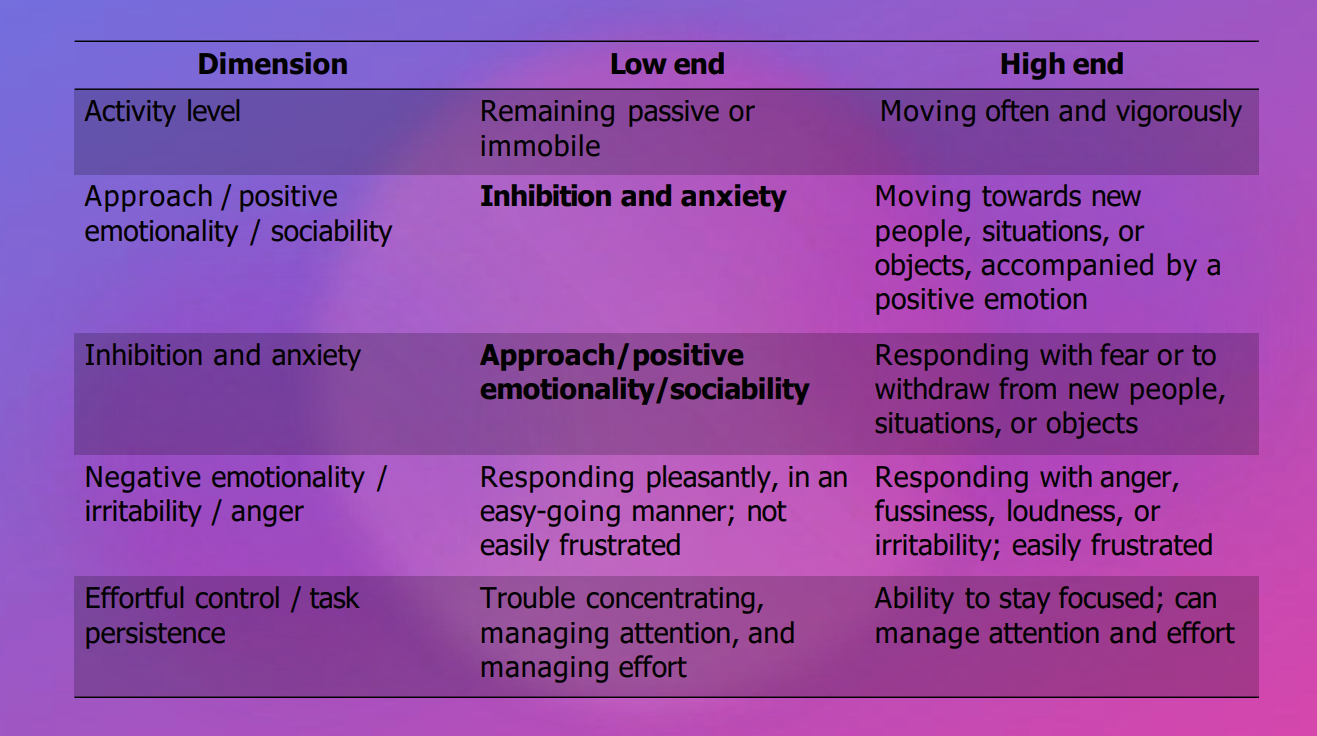
4) Irritability (AAIIE)
(Temperament → theoretical POV → AAIIE)
AKA negative emotionality/anger
Low end: Responding pleasantly, in an easy-going manner, not easily frustrated
High end: Responding with anger, fussiness, loudness, or irritability, easily frustrated
"All Amazing Individuals Inspire Excellence"
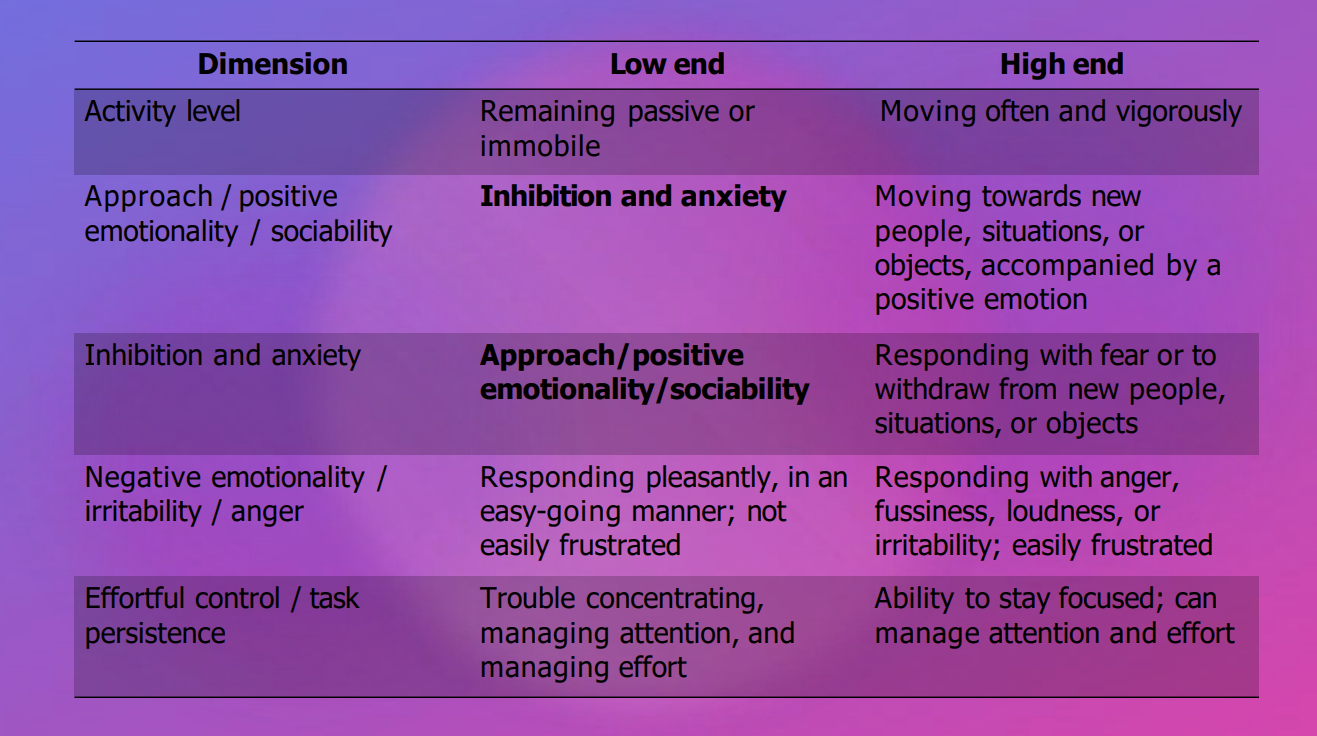
5) Effortful control/task persistence (AAIIE)
(Temperament → theoretical POV → AAIIE)
Low end: Trouble concentrating, managing attention and effort
High end: Ability to stay focused, can manage attention and effort
"All Amazing Individuals Inspire Excellence"
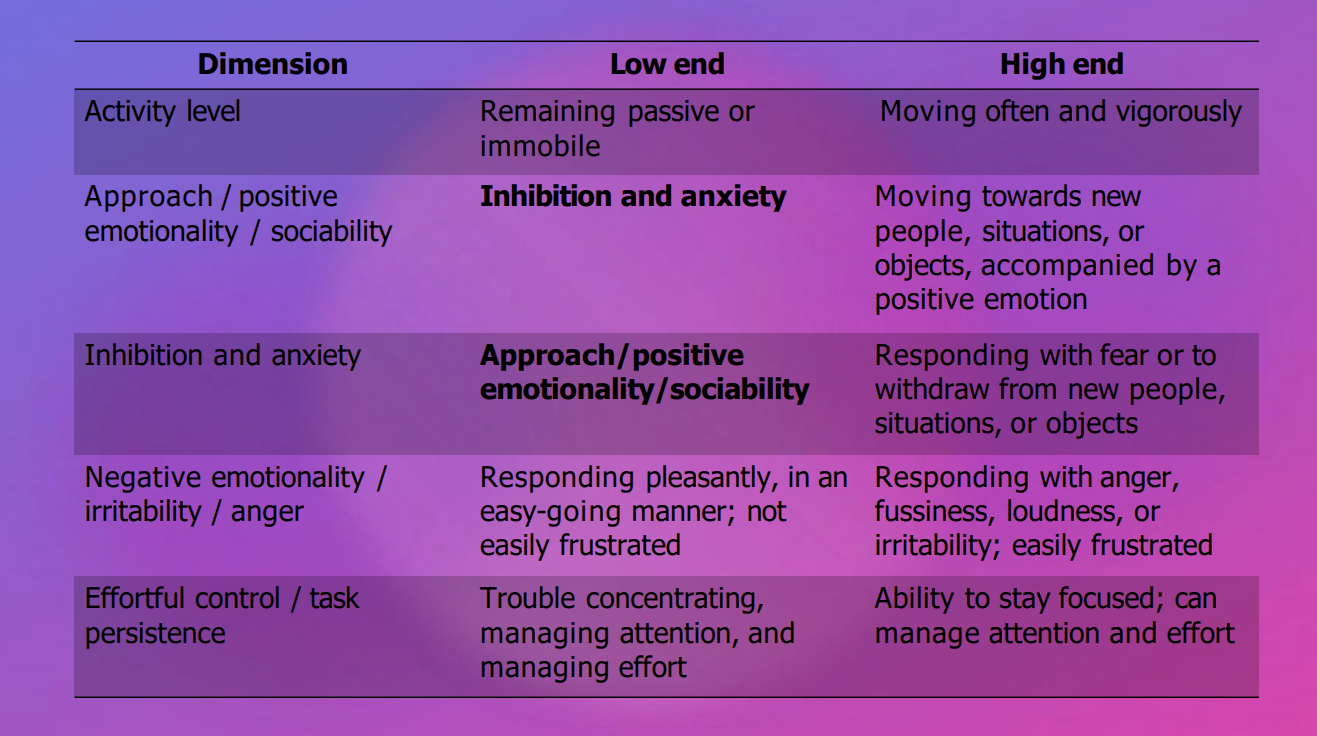
Origins of temperament
(Temperament)
Differences appear as early as prenatal period
Genetic factors: identical twins have more similar temperament than fraternal twins
Epigenetic factors: Many genes account for HALF (50%) of temperament → mechanisms controlling their expression also influence temperament
Prenatal exposure to numerous factors influence epigenetic changes
Underlying physiological patterns:
Genes controlling neurotransmitters (dopamine and serotonin)
They regulate the brain’s response to new info and unusual situations
Frontal lobe asymmetry
Interpersonal milieu
Frontal lobe asymmetry + temperament
(Temperament → Origins)
Infants with this are shy— unclear whether these neurological diff. cause diff in temperament or are CAUSED by these differences
Interpersonal milieu
(Temperament → Origins)
These interactions strengthen built-in qualities… innate temperamental tendencies can be amplified or moderated by parents’ behaviour
Niche-picking
Goodness of fit
Niche-picking
(Temperament → Origins → Interpersonal milieu)
Process of selecting experiences on the basis of temperament — occurs at all ages
Goodness of fit
(Temperament → Origins → Interpersonal milieu)
Degree to which baby’s temperament is adaptable to their environment and vice versa— influences manifestation of innate temperamental characteristics later in life
Temperamental stability
(Temperament)
Some aspects are stable across the lifespan— positive affectivity + disinhibition predict extroversion
Negative emotionality and low sociability predict problems with peers
Children who show inhibition continue to be fearful later in life
Self-concept
Freud: Infant needs “SENSE OF SEPERATENESS” form mother before forming sense of self
Piaget: Infant needs to understand “OBJECT PERMANENCE: before self-permanence
Both comprise the parts of ____________.
Subjective self: awareness that one is a separate person who exists across time and space who can act on environment
Synchrony → very important. “I smile, mommy smiles back”
Objective self: understanding that someone is an object in the world, defined by various categories
Does baby try to wipe the spot from own face or reflection?
Emotional self
2-3 months: Emotional self starts when babies ID changes in emotion expressed in other people’s faces — originally require feedback from MULTIPLE things (facial expression, tone..) and are better with those they know. Express sadness and anger
5-7 months: Can determine from one modality (thing), and determine stranger’s emotions, and can respond to wider range. Express fear
8-10 months: Can use perception of others’ emotions to anticipate and guide own behaviour. Can calm self in response to certain expected caregiver behaviours
1 year: Early morality → expects adults to act in a way that will benefit others
17 months: Expect adults to care for ingroup, helping outgroup is optional → can recognize ingroup VS outgroup
18 months: Express embarrassment, pride and shame
Awareness of others’ intentions
Awareness that others have distinct intentions/internal mental states
Joint attention: Two people focusing attention on an object w/ awareness that the other person is attending to the same object
Maker of awareness of others’ intentions
Develops around 2yrs later
Related to behavioral, emotional, intellectual and language abilities
Parental leave
Big spike in Canada of working mothers (17% in 1967, and 70% in 2015)
Paid parental leave increased number of parents (mothers AND fathers), staying home after having/adopting child
Moms tend to take much longer, about 1-2 years off while fathers take 1 month or less (duh, mom is post partum)
Parental leave → usually means mothers breastfeeding for the recommended 6 months
40% increase in Canadian moms breastfeeding exclusively for the first 6 months